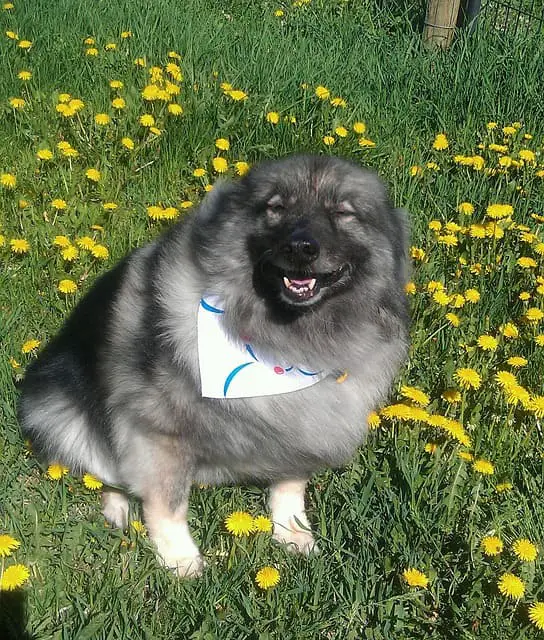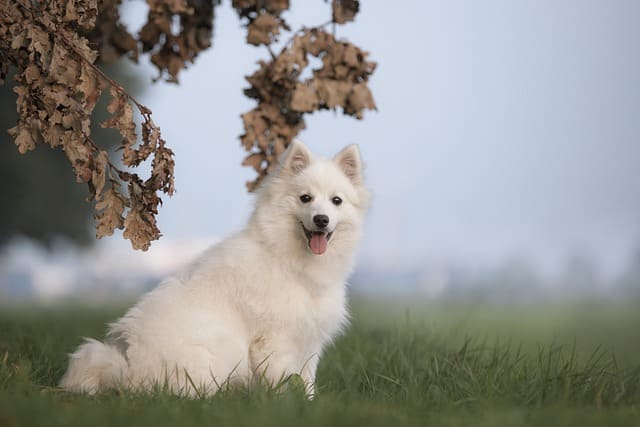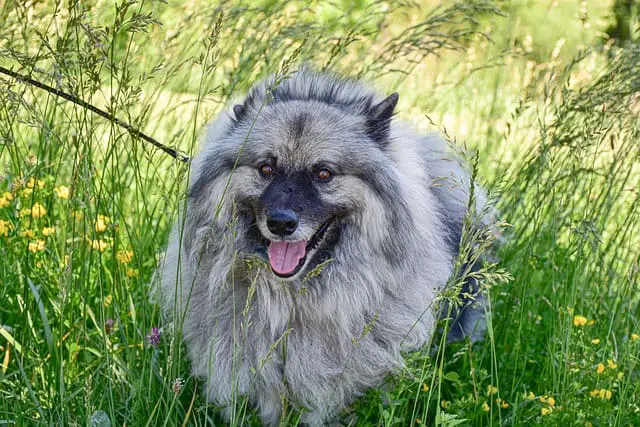The Keeshond Dog Breed: A Comprehensive Analysis of Pros and Cons
Keeshonds, often referred to as “smiling Dutchmen” due to their characteristic expression, are a fascinating and charming breed that has been capturing the hearts of dog lovers for centuries. Their distinctive appearance, rich history, and friendly demeanor make them an appealing choice for many prospective dog owners. In this extensive article, we will delve into the pros and cons of the Keeshond dog breed, helping you make an informed decision if you are considering bringing one of these delightful dogs into your life.

Pros of Owning a Keeshond
1. Adorable Appearance
Keeshonds are known for their captivating and smiling expressions. Their plush, double-layer coat, upright triangular ears, and luxurious mane of fur around their neck give them an elegant and regal appearance. Their expressive eyes, coupled with a fox-like face, add to their charm.
2. Friendly and Social
One of the most prominent characteristics of Keeshonds is their friendly and social nature. They are known for being affectionate and outgoing, which makes them excellent companions for families and individuals alike. Keeshonds often thrive on human interaction and are great with children and other pets when properly socialized.
3. Intelligence and Trainability
Keeshonds are intelligent dogs that love to learn and please their owners. They respond well to positive reinforcement training methods and excel in obedience training and agility exercises. Their eagerness to learn and engage with their owners makes them a popular choice for dog sports and competitions.
4. Loyal and Devoted
Keeshonds are remarkably loyal and devoted to their families. They form strong bonds with their owners and are known to be protective without being aggressive. This loyalty and devotion create a strong sense of companionship and make them an ideal choice for those seeking a devoted and loving pet.
5. Moderate Exercise Needs
While Keeshonds have a fair amount of energy, their exercise requirements are moderate compared to some other breeds. They enjoy daily walks and playtime but do not demand intense physical activity. This makes them suitable for families or individuals with various lifestyles, including those living in apartments.
6. Bark but Not Bite
Keeshonds are known for their vocal nature, and they will bark to alert their owners to anything unusual. This makes them excellent watchdogs. They are naturally cautious and will let you know if something is amiss, but their temperament is not aggressive, making them well-suited for families and households with children.
7. Hypoallergenic Coat
Keeshonds have a thick double coat that does shed, but their shedding is relatively minimal and less allergenic compared to many other breeds. Regular grooming and brushing are necessary to keep their coat in good condition and minimize shedding.
Cons of Owning a Keeshond
1. Grooming Requirements
The luxurious coat of the Keeshond, while beautiful, requires consistent maintenance. Regular brushing is necessary to prevent matting and reduce shedding. Additionally, their double coat can become a challenge during shedding seasons, as the shedding can be more pronounced.
2. Potential Health Concerns
Like many breeds, Keeshonds are susceptible to certain health issues. Some common health concerns include hip dysplasia, progressive retinal atrophy, hypothyroidism, and luxating patellas. Responsible breeders conduct health screenings to reduce the risk of passing on genetic conditions, but it’s essential for Keeshond owners to be prepared for potential veterinary costs as their dogs age.
3. Separation Anxiety
Keeshonds are social dogs that form strong bonds with their owners. While this can be an advantage in terms of companionship, it can also lead to separation anxiety when left alone for extended periods. Keeshonds may exhibit anxious behaviors such as excessive barking or destructive tendencies if they feel isolated.
4. Not Ideal for Hot Climates
The Keeshond’s thick double coat is well-suited for cold or temperate climates, but it can be a drawback in hot regions. These dogs can easily overheat, making them uncomfortable and potentially at risk for heat-related health issues. Special care and precautions are necessary in warmer climates.
5. Moderate Shedding
While Keeshonds are considered a relatively low-shedding breed, they do shed consistently throughout the year. Regular grooming and brushing are required to keep their coat in top condition and to minimize loose fur around the house. Shedding can be more pronounced during seasonal transitions.
6. High Cost
Acquiring a Keeshond from a reputable breeder can be relatively expensive. Additionally, the cost of ongoing care, including grooming, veterinary expenses, and quality dog food, can add up over time.
7. Prone to Obesity
Keeshonds have a tendency to gain weight if not provided with proper exercise and a balanced diet. Obesity can lead to various health issues and reduce the dog’s quality of life. It’s essential to monitor their weight and provide them with regular exercise to maintain their health.
History and Background
Before delving further into the pros and cons, it’s valuable to understand the history of the Keeshond breed. Keeshonds have a rich history dating back centuries, with origins in the Netherlands. The breed is named after a Dutch Patriot leader of the 18th century, Cornelis (Kees) de Gyselaer, who owned a Keeshond as a symbol of his political party.
Keeshonds were often used as watchdogs on riverboats and barges in the Netherlands, and their distinctive appearance and guarding abilities made them popular in the region. They were known for their ability to alert their owners to danger and their loyalty to the Dutch people.
Over time, the Keeshond’s popularity spread beyond the Netherlands, and they became beloved pets in various parts of the world. Their distinctive appearance and friendly demeanor have made them a sought-after breed, known for their versatility as both companion animals and working dogs.
The Keeshond’s Role as a Companion Dog

Keeshonds excel as companion dogs for a variety of reasons:
1. Friendly and Loyal: Keeshonds are renowned for their friendly and loyal nature. They are affectionate and enjoy being close to their human family members. Their loyalty fosters a strong bond with their owners, making them wonderful companions.
2. Good with Children: Keeshonds are generally good with children, and their gentle and patient nature makes them well-suited for families. However, as with any dog, it’s crucial to teach children how to interact with dogs safely.
3. Watchful and Alert: Keeshonds are excellent watchdogs. Their barking serves as an alert to any unusual activity or potential threats, making them a valuable addition to your home security.
4. Versatile and Adaptable: Keeshonds can adapt to various living situations, including apartments, provided they receive adequate exercise and mental stimulation. They are not overly demanding in terms of exercise and can thrive in urban environments.
5. Intelligent and Trainable: The Keeshond’s intelligence and eagerness to please make them highly trainable. They are quick learners and enjoy participating in training activities and tricks.
6. Hypoallergenic Qualities: While Keeshonds do shed, they are considered a hypoallergenic breed, as their shedding is relatively minimal, and they produce fewer allergens than some other breeds.
Common Health Concerns in Keeshonds
Like all breeds, Keeshonds are prone to certain health issues, including:
1. Hip Dysplasia: Hip dysplasia is a common orthopedic issue in dogs. It occurs when the hip joint does not develop correctly, leading to arthritis and pain. Regular veterinary check-ups and responsible breeding practices can help reduce the risk of hip dysplasia.
2. Progressive Retinal Atrophy (PRA): PRA is a genetic condition that leads to the degeneration of the retina, eventually causing blindness. Responsible breeders test for PRA to minimize the risk of passing it on to offspring.
3. Hypothyroidism: Hypothyroidism is a condition where the thyroid gland does not produce enough thyroid hormone. This can lead to a variety of health issues, including weight gain, skin problems, and lethargy.
4. Luxating Patellas: Luxating patellas, or kneecaps that slip out of place, are relatively common in small to medium-sized breeds like Keeshonds. This condition can cause lameness and discomfort.
5. Allergies: Some Keeshonds may be prone to allergies, which can manifest as skin irritation, itching, and discomfort.
6. Bloat: Bloat is a potentially life-threatening condition in which the stomach twists and traps gas, leading to a rapid expansion of the abdomen. Keeshonds, like other deep-chested breeds, may be more susceptible to this condition.
Responsible breeders conduct health screenings and tests to reduce the risk of genetic conditions in their breeding lines. It’s crucial to choose a breeder who prioritizes the health of their dogs.
Grooming and Coat Care
Keeshonds have a beautiful double coat that consists of a soft, dense undercoat and a longer, harsh guard coat. The coat is most pronounced around the neck, forming a distinctive “mane,” and the fur on the tail is plume-like.
Grooming is a significant aspect of Keeshond care. The double coat sheds year-round, with more noticeable shedding during seasonal transitions. To keep the coat in top condition and minimize shedding, regular brushing is necessary. A daily or weekly brushing routine can help remove loose fur and prevent matting.
During shedding seasons, more frequent brushing may be required to manage the increased fur loss. Owners should also be prepared for the occasional “blowout,” during which the dog may shed its undercoat more profusely.
In addition to brushing, regular bathing and nail trimming are part of a typical grooming routine. It’s essential to introduce puppies to grooming practices early to ensure they are comfortable with the process.
Exercise and Mental Stimulation
Keeshonds have moderate exercise needs. While they are not excessively active dogs, they do enjoy daily walks and playtime. Mental stimulation is equally important for this intelligent breed. They thrive on engaging activities, including interactive toys, obedience training, and dog sports.
Providing your Keeshond with both physical and mental exercise is essential to prevent boredom and any associated undesirable behaviors. They enjoy being part of family activities and should not be left alone for extended periods.
Dietary Requirements
Keeshonds can have specific dietary needs. Like all dogs, they require a balanced diet that provides essential nutrients for their overall health. Some Keeshonds may be prone to food allergies, so it’s crucial to select a high-quality dog food that does not contain common allergens.
It’s advisable to consult with a veterinarian to determine the best diet for your Keeshond, taking into account their age, activity level, and any specific dietary considerations. Maintaining a healthy weight is essential, as Keeshonds can be prone to weight gain, which can lead to various health issues.
Temperament and Personality
Keeshonds are known for their pleasant temperament and friendly disposition. They are often described as alert, outgoing, and good-natured. Here are some key aspects of the Keeshond’s personality:
1. Sociable: Keeshonds are naturally social dogs. They enjoy being around people and are often welcoming to strangers. This makes them excellent companions for social events and gatherings.
2. Playful: Keeshonds maintain a playful and youthful spirit well into adulthood. They enjoy interactive games and can be quite entertaining.
3. Loyal: Loyalty is a defining trait of the Keeshond. They form strong bonds with their human family members and are protective without being aggressive.
4. Alert: Keeshonds are naturally cautious and will bark to alert their owners to any potential dangers or unusual activities. This trait makes them excellent watchdogs.
5. Intelligent: Their intelligence makes them responsive to training and eager to please. They excel in obedience training and can learn a wide range of commands and tricks.
6. Affectionate: Keeshonds are affectionate dogs that enjoy physical contact and cuddling with their owners. They thrive on human interaction.
7. Adaptability: Keeshonds can adapt to various living situations, from city apartments to suburban homes. However, they do best in homes with active family members who can provide them with attention and exercise.
Conclusion

Keeshonds are a delightful breed known for their charming appearance, friendly demeanor, and affectionate nature. While they possess numerous qualities that make them wonderful companion animals, it’s crucial to be aware of potential challenges, such as grooming requirements, health concerns, and their need for companionship and mental stimulation.
For those who are prepared to invest time and effort into regular grooming and providing a loving and stimulating environment, the Keeshond can be a loyal and devoted addition to your family. As with any breed, responsible ownership and care are essential to ensure a happy and healthy life for your Keeshond companion.